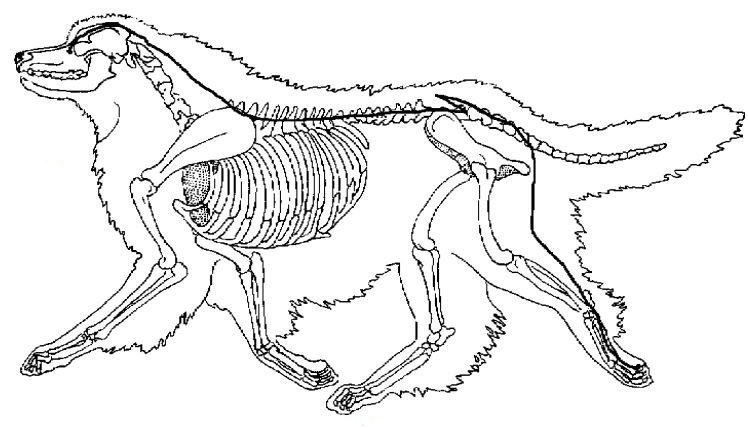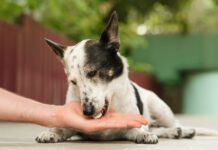[Updated August 22, 2018]
If not for their dinner bowls, dogs would still be wolves. In many ways our devoted, domesticated dogs are still wolves, especially when it comes to their digestion. In the past 10 years, holistically oriented guardians and healthcare practitioners have become proponents of fresh food diets plus supplements for dogs. There are many authoritative books, journals, and magazines that are doing their best to raise the consciousness of the general public about the health issues associated with manufactured dog foods.
Has anyone seen a canine in the wild strike a match, set a fire, and roast his food? There is a simple reason why we have never seen a dog cook his food: most dogs do not need cooked food. Usually, their digestive tracts do all the “cooking” necessary to make the nutrients from the food bio-available. But not all dogs are able to digest a raw diet; some dogs function better with home-cooked food. The goal is to provide our canines with high quality food from which they can derive absorbable nutrients.
In Traditional Chinese Medicine, the stomach, spleen, and liver are responsible for the initial “ripening and rotting” of food and its transformation into nutrient-rich blood and chi (also seen as Qi, pronounced “chee”) or life-promoting energy, and transporting them throughout the body.
When a dog digests his food and absorbs nutrients properly, his eyes are bright, his energy is good, his coat appears healthy, and he has a general vitality and attitude that we interpret as being a healthy dog.
Unfortunately, nutrient deficiencies and unnecessary food additives in processed food can cause severe health problems that are not readily seen in the short term. As the dog’s system becomes compromised due to poor quality food, age, insufficient or excessive exercise, and exposure to environmental toxins, his body will lose its resilience. An overburdened system will become imbalanced and give way to disease.
The first line of defense against ill health for your dog is the quality of fresh food he eats, along with all the other aspects of a healthy lifestyle, including a balance of rest and exercise, play, and focused training or work, plus human and canine companionship.
Restoring Your Dog’s Chi Balance
However, even with attention to his diet and all the lifestyle ingredients of a healthy dog life, there are times when a dog has an upset stomach or is not able to process and absorb his food.
When you see that your dog has a digestive problem, you can give him an acupressure treatment that will gently help restore the balance of chi within his body. Note: Bloat, whether caused by a blockage or stomach torsion, is a life-threatening condition. Seek veterinary care immediately if your dog displays the signs of bloat, especially immediately after eating: abdominal distention, depression, retching without vomiting, and excessive salivation. Holistic veterinary care is also indicated if the dog exhibits a loss of appetite, excessive appetite, gas, diarrhea, constipation, loose or hard stools, stools that have no odor or an extremely putrid odor, stools with undigested pieces of food, and lethargy that lasts for more than a few days.
It can be insidious, but any change in your dog’s appearance or behavior may have a connection to the health and balance of his digestion system. His hair is a good indicator of the health of blood and the circulation of blood and chi. Check your dog’s coat for excessive dryness or stickiness, loss of hair, or color change. These can be indicators for the need to support the spleen’s ability to function optimally. If your dog’s behavior shifts and he becomes aggressive, overly timid, erratic, or unable to focus during training, he may be experiencing an imbalance of stomach and liver chi.
The acupressure treatment described below is designed to help restore and maintain balance within the dog’s body, with special attention to improving his capacity to digest and circulate food nutrients and nutrient chi. Most dogs are chow hounds – they eat anything and everything we feed them. Give them the opportunity to make the best of every morsel.
A Short Acupressure Session for Canine Digestion
Start by finding a comfortable location for you and your dog where it is calm and you both can relax. Slowly, take three even breaths in and out. Think about how you want to help your dog feel better; taking a moment to formulate the intent of your treatment is very important.

Begin the treatment by resting one hand near your dog’s shoulder. Using the heel of your other hand, place it at the top of your dog’s head and gently stroke down his neck, just off the midline, following the Bladder meridian (illustration). Continue stroking down to the hindquarters staying to the side of the midline. To finish, stroke down the outside of his leg to his paw. Your opposite hand can trail along the same path touching the dog lightly. Repeat this intentional stroking procedure three times on each side of your dog.
Using the acupressure points illustrated (see below), start the point work segment of the treatment. Rest one hand on your dog, wherever it is comfortable. You perform the actual point work with the other hand. Use either your thumb or two fingers, depending on what is most comfortable for you.
• Thumb technique: Place the tip of your thumb directly on the acupressure point (also called “acupoint”) at a 90 degree angle. Hold the point gently, but with intent, for about three to eight seconds.
• Two-finger technique: Put your middle finger on top of your index finger and then place your index finger at a 90 degree angle gently, but with intentional firmness, directly on the acupressure point for about three to eight seconds.

The following points help relieve gastrointestinal problems and improve digestion:
| POINT | TRADITIONAL NAME | LOCATION |
| St 36 | Leg 3 Miles | On the lateral aspect of the hind leg, about ½ – 2 inches below the knee. |
| CV 12 | Center of Power | Midway between the sternum and navel, on the ventral (underside) midline. |
| Sp 6 | 3 Yin Meeting | Medial aspect of the hind leg, above the hock along the groove of the tibia. |
| Liv 3 | Supreme Rushing | Medial aspect of hind leg, in the valley between the first and second metatarsal bones. |
| St 45 | Evil’s Dissipation | At the nail bed of the hind paw, on the medial aspect of the third digit. |
| GB 41 | Foot Above Tears | At the top of the hind paw in the valley where the fourth and fifth metatarsal bones meet. |
Watch your dog’s reaction to the point work. Healthy energy releases include yawning, deep breathing, muscle twitches, release of air, and softening of the eye. If your dog overreacts to a particular point or exhibits a pain reaction, work the acupoint in front of the reactive point or behind it. Try that point again at a later session.
To complete your treatment, trace the Bladder meridian just the way you did at the beginning of the treatment. Rest your hand comfortably on his shoulder and place the heel of your other hand just off midline of the top of his head and stoke down his neck, over his back to his hindquarters, keeping your hand to the side of his spine and down the outside of his leg. Your opposite hand can lightly trail along the same path the working hand. Repeat this procedure three times on each side of your dog.
It can take 24 hours for the dog to experience the healing effects of an acupressure treatment. Occasionally, the initial issue can seem to be worse during that time before it resolves. Repeat this treatment every third day until your dog is well and weekly after that.
OVERVIEW
1. Feed your dog the healthiest diet you can. The optimum diet consists of home-prepared fresh foods.
2. If your dog has digestive problems, consider all the possible contributors, including his stress levels, environment, exposure to toxins, and relationships. Improve what you can.
3. Use the acupressure described here to help stimulate your dog’s own healing abilities.
Nancy Zidonis and Amy Snow are the authors of, The Well-Connected Dog: A Guide to Canine Acupressure. They own Tallgrass Publishers, which offers meridian charts for dogs and other companion animals. They also provide training courses worldwide.





